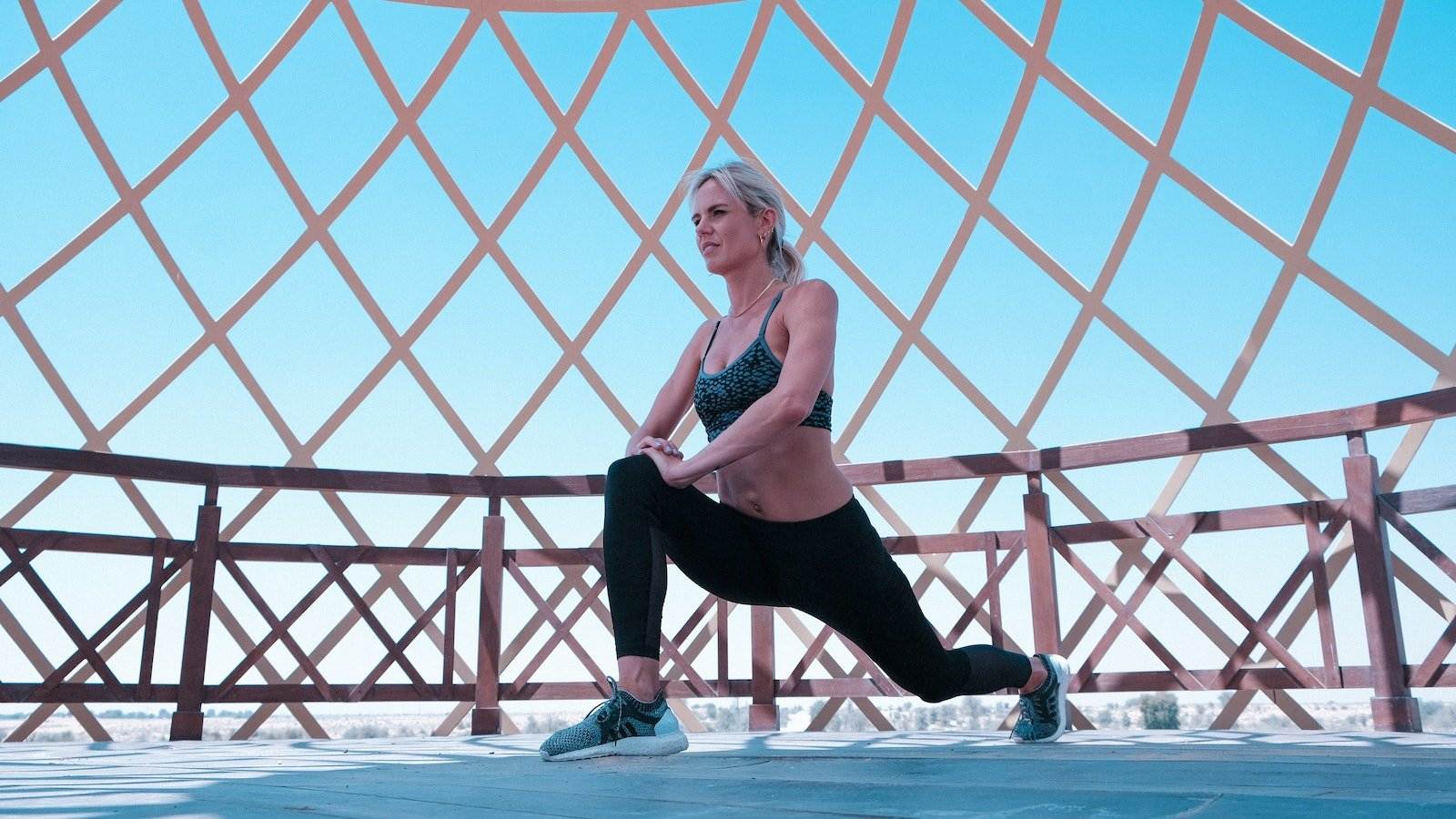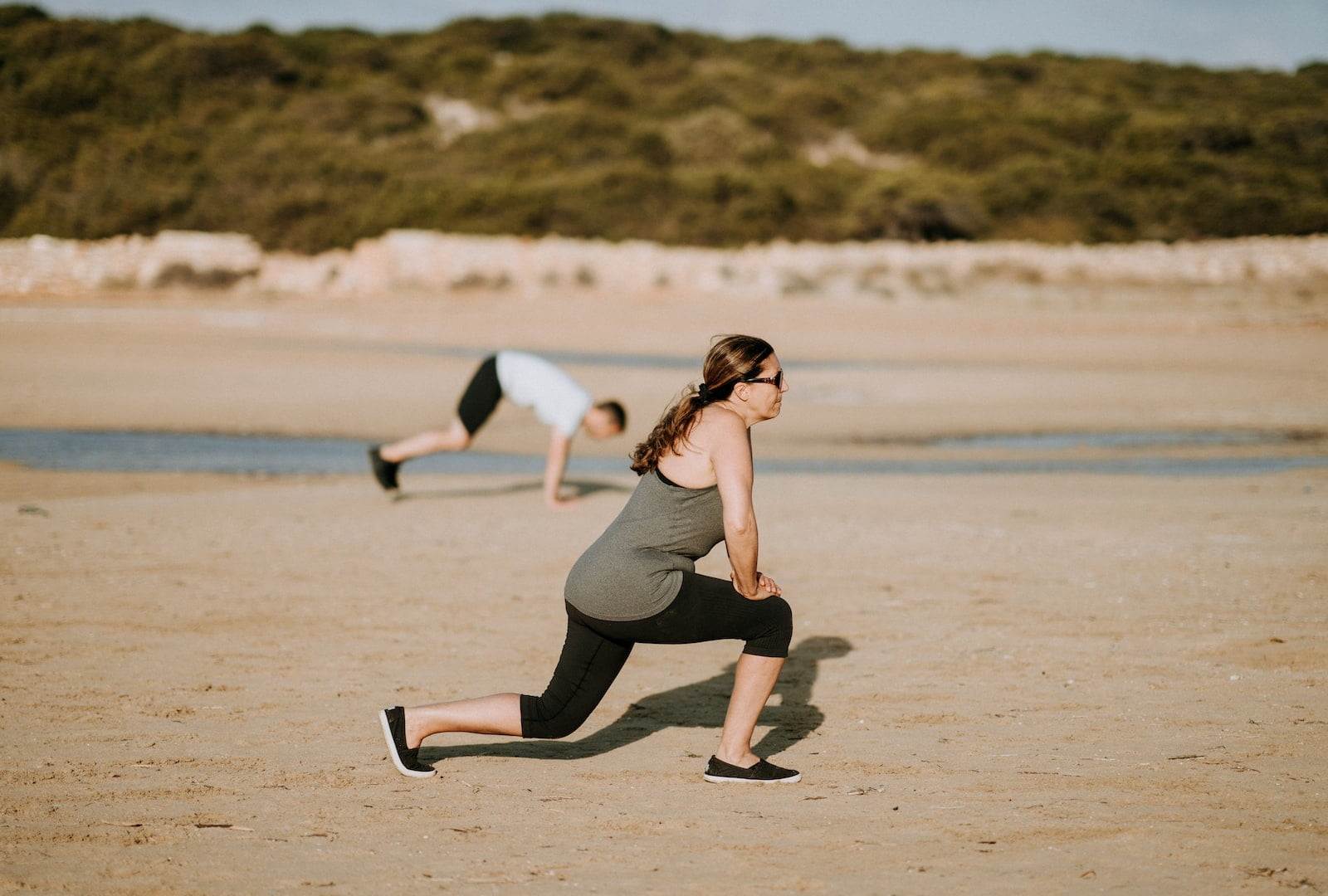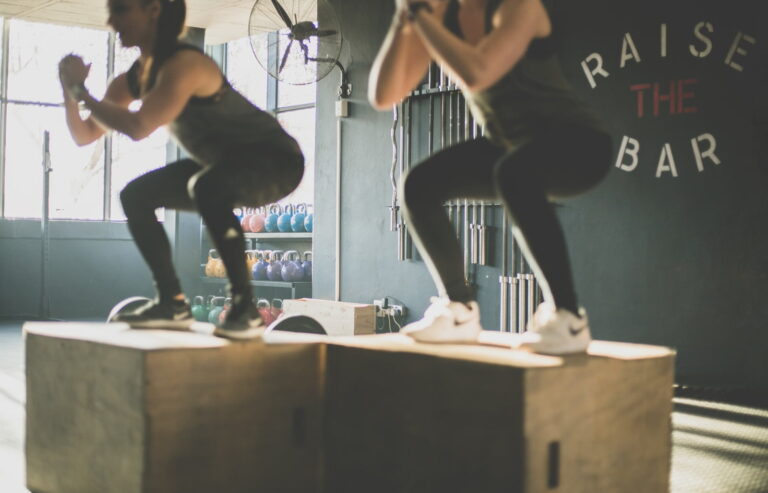Lunges are a fantastic addition to any fitness routine. This complex exercise stimulates many muscle groups including the glutes, quadriceps and hamstrings, and may be customized to suit different fitness levels and goals.
Table of Contents
Summary
Lunges enhance lower body strength and stability. Beyond strength training, they improve balance, coordination, and flexibility. We’ll go over all you need to know about it in this comprehensive tutorial, including its advantages, methods, typical errors, variants, tools, and difficulties.
Lunges are a terrific way to increase muscle and strength in the legs, hips, and glutes since they train the whole lower body. They also activate the core, which improves stability and balance.
Technique is vital when practicing lunges, since good form prevents injury and maximizes workout efficiency. Other typical faults include letting the front knee extend past the toes, leaning too far forward or backward, and not engaging the core.
There are several types of lunges that can target different muscle groups or offer diversity to your routine. Walking lunges, reverse lunges, side lunges, and leaping lunges are examples. Each variant offers benefits and difficulties and may be tailored to your fitness level and goals.
In addition to body weight lunges, there are several lunge exercises that may be performed with dumbbells, kettlebells, or resistance bands. These modifications can offer a challenge and increase strength and muscle.
Lunges are a great workout to add to your fitness routine. With good technique and variations, you may target several muscle groups, enhance balance and stability, and increase lower body strength and endurance.
How to do lunges
To get the most out of lunges and prevent injury, proper technique is crucial. Basic lunge instructions:
- Start with a proper posture by standing tall with your feet hip-width apart.
- Take a stride forward with your right foot while maintaining your core engaged and your back straight. This position helps you keep proper posture while exercising.
- Lower your body by bending your knees until your right thigh is parallel to the ground. To maximize the workout, keep your left knee just above the ground.
- Press through your right heel to stand up. This exercise will assist your glutes and hamstrings.
- Start with your left foot forward and repeat the technique on the opposite side. This balances your body.
Lunges can be modified to enhance difficulty and target certain muscle groups. Reverse lunges can assist to work your quadriceps, while walking lunges can enhance your balance and coordination. Jump lunges increase explosiveness and cardiovascular fitness.
By including different variants of lunges into your training routine, you may challenge your body and improve outcomes over time. Always start with appropriate form and raise the effort as you get used to the exercise.
Benefits
Lunges are a great fitness routine addition. They can help your physical and mental wellbeing. Lunges provide the following main advantages:
- Improve lower body strength and muscle tone. These muscles are necessary for daily activity, such as walking, climbing stairs, or carrying groceries. By strengthening them, you can increase your mobility and fitness.
- Enhance balance and stability by shifting weight to one leg at a time. For the elderly or those who struggle with balance, this can be extremely beneficial.
- Promote flexibility and range of motion by requiring entire range of motion. Athletes and people who desire to increase their mobility can benefit from this.
- Enhance posture and core strength. As you do, your core muscles help support your body. This can improve posture and alleviate back discomfort.
- A complex exercise, which means they engage many muscle groups at once. This can assist raise metabolism and calorie burn, leading to weight reduction and fitness.
- This helps desk workers and sedentary people.
- Exercising boosts happiness and confidence. By adding it to your fitness routine, you might feel more confident and energized.
By adding it to your fitness routine, you may experience all of these benefits and more. Why not try them to enhance your physical and emotional health?

Common lunge mistakes
Lunges are a great way to build your legs, thighs, and glutes. To avoid injury, complete them appropriately. Here are some more tips:
- Before lunges, perform some mild cardio or stretching.
- To intensify your lunges, add weights or resistance bands.
- Another form of lunges is the walking lunge, which includes taking steps and lunging forward with each stride. This alternative might spice up your training routine.
- Stop exercising and see a doctor if you hurt.
- Be hydrated and nourish your body with nutrients to complement your training routine.
By following these suggestions and focusing on perfect technique, you may optimize the advantages of lunges and minimize injury. While starting an exercise routine, keep in mind that consistency is vital.
Various types of lunges
There are many various types of lunges to select from in your fitness routine, each with its own rewards and obstacles. Reverse lunges tone glutes and hamstrings, while walking lunges increase balance and coordination. Side lunges work the inner and outer thighs, while curtsy lunges work the inner thighs and glutes. Finally, leaping lunges are a difficult version that can enhance cardiovascular endurance and burn more calories than standard lunges.
By adding a variety of lunges to your exercise routine, you may not only challenge your body in various ways and prevent monotony, but also focus on different sections of your legs for a more complete lower body workout.
Lunge equipment
Lunges are an excellent exercise to include in your training routine. These can be done with only your body weight, but you should use equipment to improve the challenge and effectiveness.
Dumbbells are popular for lunges. They let you bear greater weight, which builds strength and muscle. Kettlebells can help you improve your balance and coordination. Resistance bands may be used to make it harder by adding resistance throughout the exercise.
If you want to boost the ante, try weighted vest lunges. This adds weight to your body, making activity harder. By employing equipment during lunges, you may target different muscle groups and offer diversity to your workouts, keeping you interested and motivated in your fitness routine.

Squats vs. lunges
Squats and lunges are common lower body workouts, but do they target the same muscle groups?
Squats increase lower body strength. They work your thighs, hips, and glutes, but also your core. Squats can aid with posture, balance, and coordination.
They target the same muscle areas as squats but demand more stability from the core and legs. Lunges increase hips and knees’ range of motion.
While these workouts target comparable muscle regions, they have different advantages. Squats can increase lower body strength and posture. Lunges develop unilateral strength and stability and flexibility.
In this section, we compare squats and lunges to help you choose the right workout for your fitness objectives.
Muscles worked in lunges
Lunges are a great compound workout to strengthen and tone your lower body. They strengthen your glutes, quads, hamstrings, calves, and core muscles.
To get the most out of your lunges, do them correctly. Keep your upper body straight, activate your core muscles, and take a long stride. You may also alter your lunges by adding weights or doing walking lunges or reverse lunges.
Lunges can help you reach your fitness goals by targeting several muscle groups in your training routine. it is a flexible and effective exercise that may help you gain strength, enhance stability, or tone your lower body.
Beginners lunge tips
If you’re new to lunges, start cautiously and pay attention to your form. Pay care to your knees, hips, and ankles when executing it. Keep these joints aligned to minimize injury risk and enhance workout benefits.
To get started with lunges, you might want to start with bodyweight lunges. This will allow you to focus on good form without adding resistance. As you become used to the workout, add repetitions and weights.
Use a mirror to check your form before beginning. If you’re not sure if you’re performing the exercise right, this can assist. By checking your form in the mirror, you may maximize yours.
Listen to your body when performing it. If you’re in pain, stop and let your muscles recuperate. Depending on your fitness level, you may also adapt the workout to make it simpler or more difficult.
By using these recommendations, you may safely and efficiently add it to your fitness routine and get its many advantages.

Advanced lunge variations
If you want to take your lunges to the next level and challenge your muscles, there are several advanced lunge variants you can add to your exercises. These variations challenge your muscles in unique ways and can help you break plateaus and get better results. Here are some advanced lunge variants to consider:
- Bulgarian split squats: This variation includes placing one foot behind you on a bench or other elevated surface while lunging forward with the other leg. Your glutes, quadriceps, and hamstrings will be worked out in this challenging variant.
- Jumping lunges: This version includes fast switching legs while jumping from one lunge posture to another. This version builds strength and explosiveness in your legs.
- Plyometric lunges require leaping as high as possible with each lunge. This version strengthens legs.
- Walking lunges with weights: In this version, you carry weights in your hands while performing walking lunges. This variant adds resistance to lunges and builds leg and glute strength.
- Side lunges with weights: This version includes stepping to the side with one leg while keeping the other leg straight. This variant addresses glutes, inner and outer thighs.
By adding these advanced lunge variants to your fitness routine, you may challenge your muscles and get better results. You’ll never tire of lunges!
Conclusion
Lunges are a diverse and efficient kind of exercise that may help you improve your fitness and reach your objectives. To spice up your training routine, try different lunges. They include forward lunges, reverse lunges, side lunges, and walking lunges. Lunges can be made more difficult by adding weights or resistance bands. Advanced lunges, such leaping or curtsy, can boost your exercise.
When executing lunges, it’s crucial to maintain good form to minimize injury and maximize efficacy. Keep your knees behind your toes and your back straight throughout the exercise. Listen to your body and alter lunges as required. Ultimately, enjoy the trip to a stronger and healthier self and take satisfaction in your success.
FAQs
Q. How many lunges should I perform throughout my workout?
There is no universally accepted answer to this issue since the optimal amount of lunges each workout varies depending on your fitness level, your goals, and how the exercise fits into your entire fitness routine. Beginners could begin with two sets of 10–12 lunges each leg, while more experienced people might begin with three sets of 15-20 lunges.
Q. Do lunges aid in weight loss?
Certainly, lunges can aid in weight loss when accompanied with a good diet and regular exercise routine. It can assist increase metabolism and calorie burn, resulting in long-term weight loss since they train numerous muscle groups at once.
Q. When performing lunges, are there any typical errors to avoid?
Yeah, some frequent lunges faults include allowing the front knee extend past the toes, leaning too far forward or backward, and not engaging the core. Focusing on technique and form is essential for staying healthy and getting the most out of your workouts.
Q. If I have knee or hip issues, can I still perform lunges?
Before starting any new workout routine, it’s always wise to consult your doctor if you have knee or hip issues. Lunges may need to be modified or substituted with other exercises, depending on your individual situation.
Q. Can I perform lunges every day?
Lunges are a terrific exercise but you shouldn’t perform them every day since your muscles require rest and recuperation time. Lunges should be a part of your fitness routine thrice to thrice a week at the most, and you should rest your muscles on the other days.
Q. Should I perform lunges before or after cardio?
Depending on your tastes and fitness objectives, you may perform it either before or after exercise. While some choose to perform cardio first to warm up their muscles, some people prefer to undertake strength training activities like lunges before cardio to make sure they have enough stamina for the more taxing workouts. The sequence doesn’t really matter as long as you incorporate both forms of exercise into your routine.
Q. How long does it take to get effects from performing lunges frequently?
You should expect to see improvements from performing lunges frequently in anywhere from a few weeks to a few months, depending on your current fitness level, the frequency with which you perform lunges, and how well they fit into your entire fitness routine. Yet, with constant practice and appropriate form, you can observe gains in lower body strength, balance, and coordination in a matter of weeks or months.


